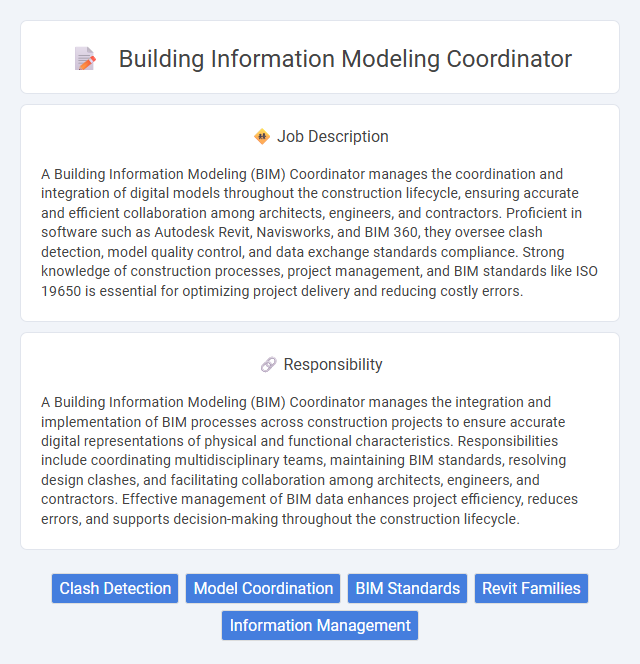
A Building Information Modeling (BIM) Coordinator manages the coordination and integration of digital models throughout the construction lifecycle, ensuring accurate and efficient collaboration among architects, engineers, and contractors. Proficient in software such as Autodesk Revit, Navisworks, and BIM 360, they oversee clash detection, model quality control, and data exchange standards compliance. Strong knowledge of construction processes, project management, and BIM standards like ISO 19650 is essential for optimizing project delivery and reducing costly errors.
Individuals with strong analytical skills and a keen eye for detail are likely suitable for a Building Information Modeling Coordinator role, as it demands precise management of digital construction models. Candidates who excel in communication and collaboration may probably thrive in this position due to the need for coordinating between architects, engineers, and contractors. Those less comfortable with technology or multitasking might find this role challenging given the technical and organizational complexities involved.
Qualification
A Building Information Modeling (BIM) Coordinator requires advanced proficiency in BIM software such as Revit, Navisworks, and AutoCAD, alongside a strong background in architecture, engineering, or construction management. Essential qualifications include expertise in 3D modeling, clash detection, and project coordination, with certification in BIM execution planning often preferred. Effective communication skills and knowledge of industry standards like ISO 19650 enhance collaboration between multidisciplinary teams and ensure seamless project delivery.
Responsibility
A Building Information Modeling (BIM) Coordinator manages the integration and implementation of BIM processes across construction projects to ensure accurate digital representations of physical and functional characteristics. Responsibilities include coordinating multidisciplinary teams, maintaining BIM standards, resolving design clashes, and facilitating collaboration among architects, engineers, and contractors. Effective management of BIM data enhances project efficiency, reduces errors, and supports decision-making throughout the construction lifecycle.
Benefit
A Building Information Modeling (BIM) Coordinator likely enhances project efficiency by streamlining collaboration and reducing errors through accurate 3D modeling. This role probably improves communication among architects, engineers, and contractors, leading to cost savings and timely project completion. Stakeholders may benefit from clearer visualization of project components, enabling better decision-making and risk management.
Challenge
The role of a Building Information Modeling (BIM) Coordinator likely involves managing complex data integration across multiple stakeholders, which may pose significant coordination challenges. Navigating varying software platforms and ensuring model accuracy could present frequent obstacles. The need to maintain real-time updates while balancing project timelines may further increase task complexity.
Career Advancement
Building Information Modeling (BIM) Coordinators play a crucial role in managing digital construction data and facilitating collaboration among project teams, making them indispensable in modern architecture and engineering firms. Expertise in BIM software such as Revit, Navisworks, and AutoCAD, coupled with strong project management skills, positions BIM Coordinators for advancement into senior roles like BIM Manager or Digital Project Manager. Pursuing certifications like Autodesk Certified Professional and gaining experience in interdisciplinary coordination accelerates career growth and opens opportunities in large-scale infrastructure projects.
Key Terms
Clash Detection
A Building Information Modeling (BIM) Coordinator specializing in Clash Detection plays a critical role in identifying and resolving conflicts within 3D models before construction begins. By utilizing advanced software tools such as Navisworks and Revit, they ensure interdisciplinary coordination between architectural, structural, and MEP systems to minimize costly on-site issues. Effective clash detection improves project efficiency, reduces rework, and enhances overall construction quality and timelines.
Model Coordination
A Building Information Modeling (BIM) Coordinator specializes in model coordination, ensuring seamless integration of architectural, structural, and MEP models to enhance project accuracy and reduce conflicts. They employ advanced software like Autodesk Revit and Navisworks for clash detection and model validation, facilitating effective collaboration among multidisciplinary teams. Proficiency in BIM standards, data management, and communication workflows is essential for optimizing construction project delivery and maintaining model integrity throughout the project lifecycle.
BIM Standards
A Building Information Modeling (BIM) Coordinator ensures the implementation and enforcement of BIM standards across construction projects to improve collaboration and data consistency. They manage the development of standardized protocols, templates, and workflows aligned with industry best practices such as ISO 19650 and COBie. Their role is critical in maintaining model accuracy, facilitating interoperability between software platforms, and enhancing project delivery efficiency.
Revit Families
A Building Information Modeling (BIM) Coordinator specializing in Revit Families manages the creation, organization, and standardization of Revit family components to ensure accuracy and efficiency in project workflows. They collaborate closely with design and engineering teams to customize parametric families that meet project specifications and enhance model interoperability. Expertise in Revit family management improves clash detection, reduces rework, and streamlines construction documentation processes.
Information Management
A Building Information Modeling (BIM) Coordinator specializes in information management by ensuring accurate data integration and seamless collaboration across project teams. They implement standardized workflows for model development, version control, and data exchange to maintain consistency and reduce errors. Proficiency in BIM software and strong communication skills are critical for managing digital intelligence and optimizing project delivery.
 kuljobs.com
kuljobs.com